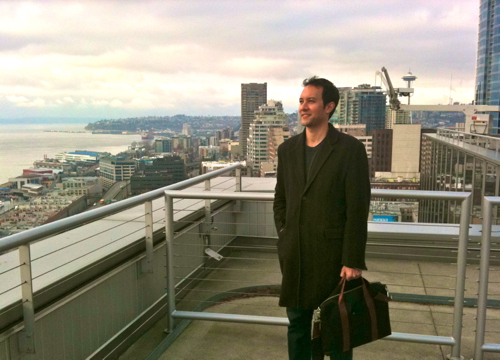 Brian Geller, executive director of the Seattle 2030 DistrictPhoto: Greg HanscomSeattle, a.k.a. the Emerald City, looms Oz-like in the imaginations of eco-minded architects and designers. Its reputation for being uber green drew architect Brian Geller to the city from New York a few years ago. Now, he looks at the skyline rising above Elliott Bay and sees how much greener the place could be.
Brian Geller, executive director of the Seattle 2030 DistrictPhoto: Greg HanscomSeattle, a.k.a. the Emerald City, looms Oz-like in the imaginations of eco-minded architects and designers. Its reputation for being uber green drew architect Brian Geller to the city from New York a few years ago. Now, he looks at the skyline rising above Elliott Bay and sees how much greener the place could be.
More than 70 percent of the electricity generated in this country goes to heating, cooling, lighting, and otherwise powering our homes, offices, and other buildings. This accounts for a whopping 38 percent of our globe-warming carbon dioxide emissions. Tighten up those buildings by adding insulation, getting smart about heating and cooling systems, etc., and you can slash the energy use by 20 to 50 percent, making a good-sized dent in your ecological footprint.
And why not start with the biggest buildings, Geller reasons, in downtown areas where per-acre energy use soars with the corporate office towers?
That’s the idea behind the Seattle 2030 District, a high-performance building zone in downtown Seattle that aims to cut energy consumption, water use, and transportation-related CO2 emissions to 50 percent of national averages by 2030. That’s for existing buildings. There are even stricter standards for new buildings — though participation in the district is voluntary.
One could argue that Seattle has a head start. Geller and his colleagues have discovered that many of the buildings in the district already meet or exceed the 50 percent goals. But therein lie some interesting lessons: For one, it’s not just the gleaming postmodern (and post-postmodern) LEED-certified skyscrapers that are performing well. Some structures built in the 1980s and even the 1920s (including the one in which Grist’s headquarters are located) hum along like well-oiled machines simply because they are managed thoughtfully.
“It’s less about the age of the building, and more about how it is run,” Geller says.
Tackling the challenge as a neighborhood, or district, has a number of advantages. As one speaker at a recent conference on “ecodistricts” in Portland pointed out, trying to make a dent in climate change working building-by-building is akin to battling deforestation one tree at a time. Districts, on the other hand, create economies of scale, and allow for cooperation between neighbors. In downtowns, Geller points out that office buildings, which are packed with people and computers, shed heat even in the colder months. Hotels, meanwhile, require year-round heating. Why not use some of the excess heat from an office tower to warm a neighboring hotel?
A little neighborly competition can also be a good thing. To make the 2030 District’s conservation challenge more tangible, Geller’s group has partnered with the company Lucid Design, which is outfitting participating buildings with “dashboards” that allow them to track their energy use over time. The data from each building will feed into a master dashboard on the Web, so the district can measure its overall progress. If building owners choose to make their data public, everyone will be able to watch their performance — and vie with them for the title of the leanest and greenest.
The 50 percent goal is district-wide, meaning that some buildings can lag as long as others overperform. And it allows some building owners a degree of flexibility, as well. In signing on, owners make no promise that they will meet all the 50 percent goals. But they do pledge to work those goals into any audits they have done of their buildings, so that they’ll be aware of just what it would take to reach them.
The 2030 District has been quick to take off. What started as an idea two and a half years ago has grown into a full-time job for Geller, who left a position at a local architecture firm this spring to run the effort, now a nonprofit. Geller says local property owners have been very enthusiastic about the challenge. Both the city and the county signed on as founding members. And in April, the Environmental Protection Agency granted Seattle a $454,000 Climate Showcase Community Grant, which was matched with $225,000 in in-kind contributions from local firms.
To address the transportation issues related to downtown buildings, the district has partnered with another local nonprofit called Commute Seattle, funded by the city, county, and downtown businesses. Building owners do their part to cut vehicle emissions by providing bike rooms, showers, and tools for basic bike repairs. Meanwhile, large offices receive discounted transit passes to encourage people to ride the bus or light rail.
Still, the 2030 District has a long way to go: Geller says the group has about 60 downtown buildings in its database so far, including some of the largest in the city. But there are 1,800 buildings within the zone. The smaller buildings could be a bigger challenge, both because their owners may lack the resources (or awareness of existing resources) to fix up their properties — and because many of them outsource management to people who juggle numerous buildings.
Many of the broader challenges with this sort of project boil down to where the money is, and isn’t. Bottom line, Geller says: “It’s often cheaper to waste energy than it is to pay someone to help you conserve it. We’ve run that to its logical conclusion. It’s time to get some people managing our buildings again.”
These days, Seattle has a little more competition for the title of top green dog than it did just a few years ago. Similar district- and city-scale energy efficiency projects are underway in New York and Washington, D.C. But Geller will continue working furiously behind the curtain to ensure the Emerald City stays on top.
Up next: A smaller, neighborhood-level conservation initiative takes root in an island community.



